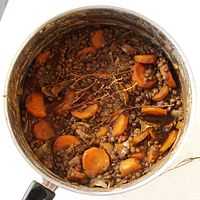Ragout
| Ragoût | |
|---|---|
|
Ragoût aux lentilles | |
| Type | Stew |
|
| |
The term ragout (French ragoût French pronunciation: [ʁaɡu]) refers to a main-dish stew.
Etymology
The term comes from the French ragoûter, meaning: "to revive the taste". The etymologically related Italian ragù is a sauce such as Ragù Napoletano used typically to dress pasta.
Preparation
The basic method of preparation involves slow cooking over a low heat. The main ingredients are many; ragouts may be prepared with or without meat, a wide variety of vegetables may be incorporated, and they may be more or less heavily spiced and seasoned.
Examples

Plated beef ragoût
Two 18th-century English dishes from The Compleat Housewife[1] show some of the varying meats, vegetables, seasonings, garnishes and procedures which can be applied to the ragoût.
A Ragoo for made Dishes
TAKE claret, gravy, sweet-herbs, and savoury spice, toss up in it lamb-stones (i.e. lamb’s testicles), cock's-combs, boiled, blanched, and sliced, with sliced sweet-meats, oysters, mushrooms, truffles, and murrels; thicken these with brown butter; use it when called for.
To make a Ragoo of Pigs-Ears
TAKE a quantity of pigs-ears, and boil them in one half wine and the other water; cut them in small pieces, then brown a little butter, and put them in, and a pretty deal of gravy, two anchovies, an eschalot or two, a little mustard, and some slices of lemon, some salt and nutmeg: stew all these together, and shake it up thick. Garnish the dish with barberries.
See also
References
| Look up ragout in Wiktionary, the free dictionary. |
- ↑ Smith, Eliza (1758). The Compleat Housewife: or, Accomplished Gentlewoman’s Companion… (16th edition ed.). London: C Hitch, etc.
